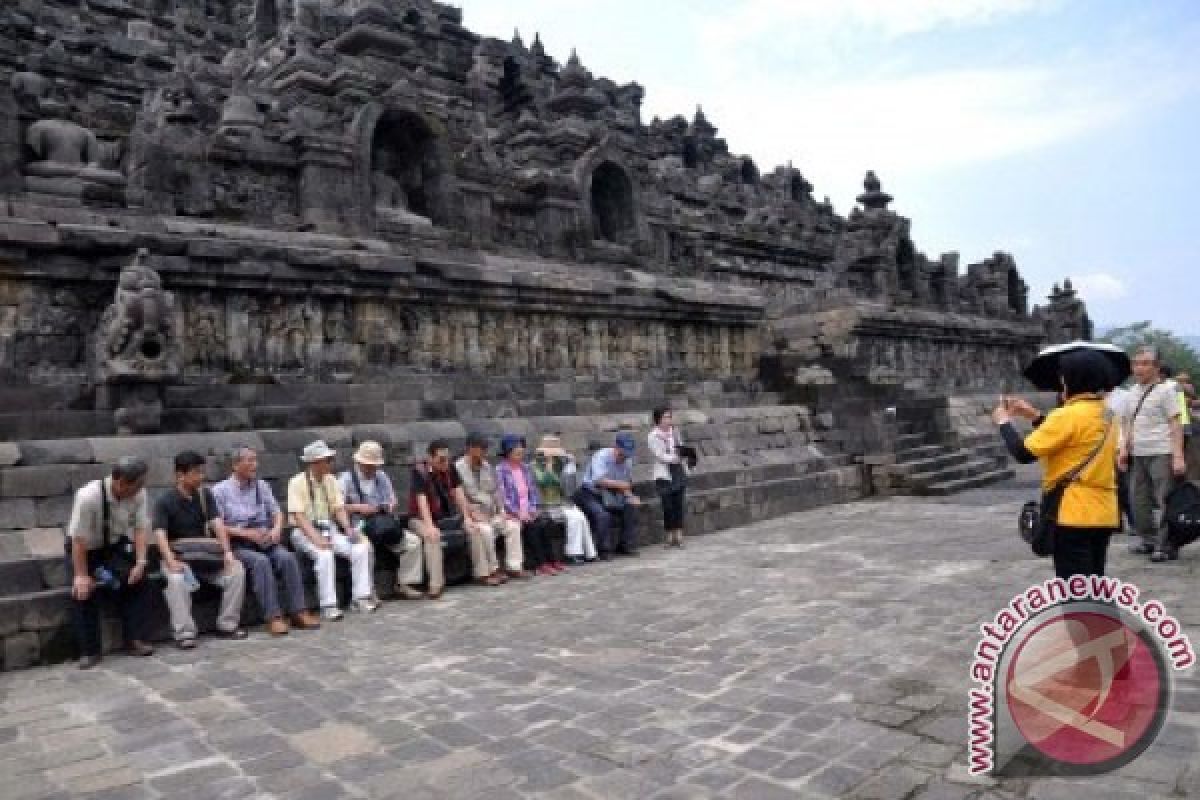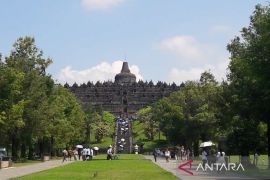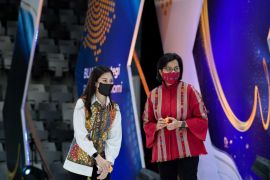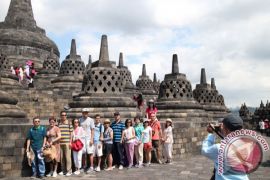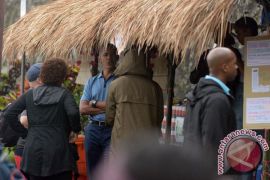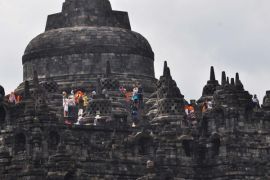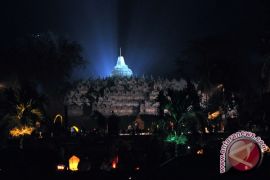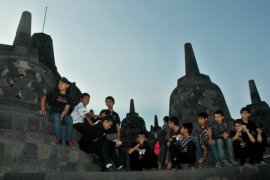The ancient temple was fully covered by the volcanic ash, forcing the local authorities to close the temple from the public to enable the preservation measures and cleanup to be carried out, a day after the explosive eruption of Mount Kelud located in Kediri-Blitar districts, East Java province.
"I was on my way to Borobudur, the ash was quite thick, visibility range dips around seven meters," the President of PT Borobudur, Prambanan, and Ratu Boko temple tourism park, Laily Prihatiningtyas, said on Feb. 14 when announcing the temporary closure.
Borobudurs 72 stupas with Buddha statues inside and the monumental open-stupa with big Buddha statue at the temples top were wrapped in German-made parachute slipcovers to protect them from heavy volcanic ash. The temples floors were also fully covered by plastic sheets.
The preservation measures were necessary although Mount Keluds volcanic ash has safe pH (acidity) range, Marsis Sutopo, the head of the Borobudur Conservation office, told the press recently.
The conservation office analyzed the pH level of ash covering Borobudur and it measured between pH 5 and pH 6 which was considered safe, he said.
"pH 7 is neutral, and the pH range of Keluds ash is categorized as safe because the acidity is quite low. It is unlikely that the ash would damage the temples andesite stone," he said at a press conference held at the Borobudur Temple tourism park in Magelang, on Feb. 14 .
Keluds ash pH level was in fact higher than pH 4 of Mount Merapis ash which erupted in 2010 and spitted ash up to Borobudur temple. Ash with pH 3 (having high acidity) could cause corrosion of the temples stone, he said.
Besides, the thickness of Keluds ash in Borobudur was only 3-5 mm, while Merapis ash was up to 3 cm tick, he added.
The conservation office also analyzed XRF (X-ray flourescence) of the Kelud ash and found out that the ash covering the whole structure of Borobudur contained silica (70.6 percent) , aluminum (9 percent), iron (5.7 percent), calcium (0.7 percent), and sulphur (0.1 percent).
"Silica could cause respiratory problem to people, while sulphur could damage stone, but the sulphur level is very low, probably because Mount Kelud is very far from Borobudur Temple," he explained.
Although the volcanic ash was quite safe, the Borobudur conservation office decided to carry out clean up and recovery efforts for 7 to 10 days to protect Borobudur and Mendut as well as Pawon temples at the supervision of UNESCO (United Nations Educational, Science, and Cultural Organization), Sutopo said.
About 3,000 to 4,000 visitors failed to climb Borobudur Temple when ash rain fell in the area on Feb. 13. "Of course there is a potential financial loss," the unit chief of the Borobudur Tourism Park, Bambang Irianto, stated several days ago.
Before the eruption, some 10 thousand to 16 thousand people usually visit Borobudur temple on Saturday and Sunday.
In addition the conservation offices staff members and military personnel, around 200-300 volunteers consisting of Buddhist devotees, hotel employees, tourist guides, local small traders, students and tourists, have helped clean the temple from the volcanic ash every day.
Around 50 students from the Mistakhurrohman Islamic boarding school located in Majaksingi village, Borobudur, Magelang district, Central Java, were among the volunteers who helped in cleaning the temple.
"Around 50 students from our boarding school spent their Friday holiday to clean Borobodur Temple of the Keluds ash together with other volunteers," Muhammad Dimyadi, a teacher from the Mistakhurrohman Islamic boarding school, stated recently.
The boarding school is located around 1.5 km from the temple. Most of the students are orphans and some are from poor families whose parents are street vendors operating around the temple. The students cleaned the temple from 8 a.m. to 3 p.m. local time.
When Mount Merapi erupted in 2010, the Islamic boarding school also sent their students to help clean the temple from the volcanic ash.
In addition to the Muslim students, around 700 Buddhists, including several monks coming from several cities in Central Java, also cleaned the temple on Friday.
"We have been working here to clean the Borobudur temple from Keluds ash since the past five days. We are from, among other things, Boyolali, Temanggung, Banjarnegara, Wonogiri, Wonosobo, and Ambarawa, Semarang district," Buddhist monk Uttamacitto from Sangha Agung Indonesia, Ampel temple located in Boyolali district, stated.
He appreciated the help from the Muslim students in cleaning the temple. The eruption of Mount Kelud spewed ash up into Borobudur temple, which was a momentum for the Indonesian people to demonstrate the spirit of unity, togetherness and tolerance, he explained.
"The cleanup has reached 80 percent, so volunteers are expected to stop working on Tuesday (Feb 25) probably," Pangga Ardiansya, the coordinator of the Borobudur Conservation Offices Public Services, said on Sunday (Feb. 23).
The final cleaning up of the temples drainage will be done by the personnel of the conservation office.
In the next two or three days, the temple will be fully cleaned and most likely be reopened to the public, he said.
"We would like to express our gratitude to all volunteers who are not only coming from Central Java, but also from Surabaya (East Java). Even several South Korean citizens who happened to be participating in the International Cultural Camp also helped clean the temple," he said.
Despite the closing of the temple due to the ash problem, around 5,000-10,000 tourists visited the area in the weekend, and 2,000-3,000 in working days. They included foreign tourists from Italy, Russia, and China.
Five days after the Kelud eruption, Borobudur temple was partly reopened on Feb. 19, namely in the parks Zone II, where tourists could go to two museums existing there and take pictures with the temple as background. The Zone I, the temples structure remains closed to the public.
"We welcome positively the reopening of Borobudur temple although it is restricted only to the Zone II, while Zone I is still closed. At least it gives opportunities to small traders to operate again and earn money from the goods they sell," Basiyo, the chairman of the association of small traders operating in the Borobudur temple tourism park.
Basiyo, who sells souvenirs, said he and his colleagues had earned nothing over the past one week because the park was closed from the public.
Besides, Borobudur, the 1,731-meter Mt Keluds ash also affected other temples in Central Java, such as Prambanan, Ratu Boko, Pawon, Mendut and Plaosan.
The huge mountain temple of Borobudur was built during the reign of a king of the Saliendra dynasty between AD 750 and 842. Located about 42 km from the city of Yogyakarta, central of Java Island, Borobudur is one of the greatest Buddhist monuments in the world and was included on the UNESCO World Heritage list in 1991, according to UNESCO on its official website.
The island of Java is located on the "Circum Pacific Ring of Fire", one of the most seismically active regions of the world.
Borobudur is surrounded by four active volcanoes: Merapi, Sindoro, Merbabu and Sumbing from which the building stones of the temple were produced.
(T.F001/A/F001/S012)
Reporter: Fardah
Editor: Aditia Maruli Radja
Copyright © ANTARA 2014
